Mark Sisson's Blog, page 78
March 27, 2020
Weekly Link Love – Edition 74

Research of the Week
Even medical students touch their face dozens of times each hour, almost 50% of the time a mucous membrane.
A clinical trial is underway looking at the effect of chloroquine on coronavirus.
A neutrophil:lymphocyte ratio indicative of insulin resistance predicts severe illness in COVID-19 cases.
ACE inhibitors and coronavirus.
Dairy appears to promote better bone mineralization in post-menopausal women.
New Primal Blueprint Podcasts
Episode 413: Karen Martel: Host Elle Russ chats with Karen Martel, expert on women’s health and weight loss.
Episode 414: Listener Q&A: Host Brad Kearns answers your questions.
Primal Health Coach Radio, Episode 53: Laura and Erin chat with Mitch Webb about the importance of establishing a strong why.
Media, Schmedia
A new coronavirus model predicts far fewer deaths. Hopefully this is accurate.
NY doctors are using IV vitamin C for coronavirus patients.
Interesting Blog Posts
Is the USDA using the latest science to determine the healthiest diet?
New editorial from Fauci on coronavirus. Seems like improved news.
Social Notes
I chuckled.
The Italian response to quarantine is to be admired.
Everything Else
Even scuba masks.
The origin of hand-washing.
What happens if you break quarantine in Punjab.
Nature versus nurture versus… noise?
Things I’m Up to and Interested In
Story I enjoyed: Regular folks are making masks with sewing machines.
Stat I found interesting: About half of NYC’s coronavirus cases are under 45 years of age; 9% of that group is hospitalized.
Video I enjoyed: How Grant Schofield and his family stay sane during lockdown.
How I’m saying hello: Jocko’s heart hammer.
More silver lining: The return of victory gardens.
Question I’m Asking
What long-term effects will the coronavirus have on the world?
Recipe Corner
Garbage stir-fry with curried cabbage.
40 recipes that freeze well.
Time Capsule
One year ago (Mar 22– Mar 28)
The Definitive Guide to Autophagy (and 7 Ways to Induce It) – What’s the deal with autophagy?
Seasonal Eating: 9 Tasty Springtime Recipes – What to make.
Comment of the Week
“Hollow body rocks are more fun to do if you pretend you’re a banana that’s rocking back and forth. We had to to them all the time in crossfit and the only way I could get through them is to say in my head “I”m a rockin’ banana!” That may just be me though. [image error]
In related mind games, it’s much easier to do a row sprint if you imagine a crocodile chasing you behind your rowboat.”
– I like that, starmice. Better make sure it’s a green banana to reduce absorbable glucose, though.

The post Weekly Link Love – Edition 74 appeared first on Mark's Daily Apple.



March 26, 2020
Microworkouts: Effective, At Home Workouts In Two Minutes or Less

A lot of us get hung up on this idea of what an exercise session is supposed to look like. We think about driving over to the gym, squeezing into a crowded class, or working through a room full of complex contraptions, machines, and heavy plates. In our minds, it has to be a certain duration or intensity, or it doesn’t count. It has to have a warm-up and a cool-down, and we’re supposed to sweat so we’ll need to shower when it’s over. That mindset turns the simple act of moving your muscles into something you don’t have time for, something you’re too tired or sore to do today, something that seems too overwhelming for the moment you’re in right now. Don’t underestimate the power of short, at home workouts.
I’m challenging you to change your mindset, emerge from our flawed, dated and narrow approach to fitness and step into a much broader perspective about what it means to be fit. The concept of microworkouts is taking hold, and being touted by emerging science, respected coaches, trainers and elite athletes. I’m seeing a shift in the way people think about how to get fit: we’ve had enough with making the same mistakes over and over.
Microworkouts: Reframing our Approach to Exercise
The revolution is definitely a work in progress, and I still see misguided and destructive marketing messages and programming being thrust upon well-intentioned fitness enthusiasts. I still see the “no pain, no gain” approach being encouraged by fitness personalities and celebrated on social media.
For those of us willing to examine outdated beliefs and behavior patterns, and replace them with simple ways to get fitter, healthier, and happier, together we can help usher in a New Fitness movement.
I can attest that things like frequent traveling, minor aches and pains limiting certain activities, or hectic periods of work can throw me off even the most regimented fitness devotee. Often I won’t even realize that my routine has been slipping until I review my workout journals and realize I haven’t bagged a formal sprint session in three weeks.
Enter microworkouts.
What are Microworkouts?
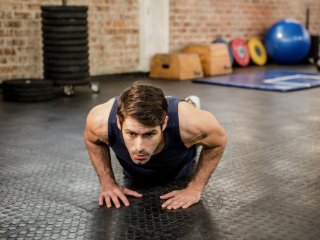 Microworkouts are quick strength moves that you do throughout the course of the day. They can take a few seconds or a few minutes, they can be structured or unstructured, and you can roll them into the more mundane parts of your day, like waiting for your morning coffee to brew or going out to get the mail. These brief, at home workouts don’t seem like much while you’re doing them, but the effects compound over time.
Microworkouts are quick strength moves that you do throughout the course of the day. They can take a few seconds or a few minutes, they can be structured or unstructured, and you can roll them into the more mundane parts of your day, like waiting for your morning coffee to brew or going out to get the mail. These brief, at home workouts don’t seem like much while you’re doing them, but the effects compound over time.
Some examples of microworkouts:
Doing calf raises every time you climb the stairs in your house
Holding a plank while you’re waiting for your smoothie to blend
Ripping out a quick set of tricep dips at your desk before every meeting
The key is that you don’t overthink it. You do it, and then it’s over until you decide to do another microworkout. Even though they involve true energy expenditure, microworkouts seem effortless. The benefits compound over time, and you don’t feel like you’re disrupting the flow of your day at all.
In Keto For Life, we call it JFW, or Just F—ing Walk. Quick, at home workouts or microworkouts outdoors might sneak in there next. If it stops there for the day, great. Or, you may be up for that long-standing foundation of structured cardio, resistance training, or sprint workouts.
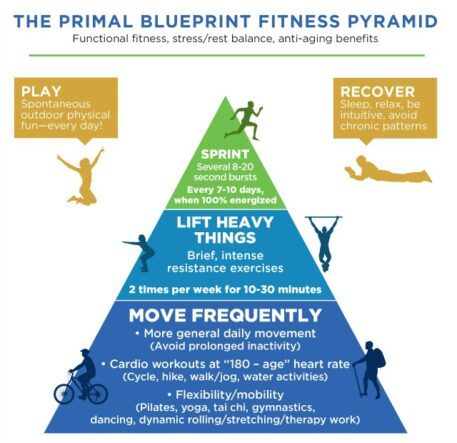 Reference the Primal Blueprint Fitness Pyramid recommending 2-5 hours per week of cardio at aerobic heart rates (180 minus age in beats per minute or below), two strength sessions per week lasting 10-30 minutes emphasizing functional, full-body movements, and one sprint workout every 7-10 days featuring all-out efforts lasting between 10-20 seconds with full rest between. These are simply guidelines. Life happens, and microworkouts are there to fill the gap.
Reference the Primal Blueprint Fitness Pyramid recommending 2-5 hours per week of cardio at aerobic heart rates (180 minus age in beats per minute or below), two strength sessions per week lasting 10-30 minutes emphasizing functional, full-body movements, and one sprint workout every 7-10 days featuring all-out efforts lasting between 10-20 seconds with full rest between. These are simply guidelines. Life happens, and microworkouts are there to fill the gap.
Mark’s August 2019 post on microworkouts attracted a ton of feedback from readers. Clearly, this concept is taking hold in the fitness scene and is poised to become a major stand-alone element of a well-balanced program. Devoted MDA reader, Primal Health Coach, and 50+ athletic wonder Stephen Rader wrote a nice article with photos here. Rader mentions that microworkouts are great for skill acquisition because they don’t wear you out and can be performed frequently. He also pointed out that the Blue Zone research is touting the concept as a winning longevity component. Here’s a helpful podcast/video from Matt Schifferle at the Red Delta Project on the subject. He makes an excellent point that frequency and consistency are fitness essentials, and it can often be difficult to achieve those with a formal workout routine.
Matt makes the clever comparison that a microworkout is like chillin’ at home and watching Netflix, or watching a quick video on your mobile device, versus a proper evening out at the movie theaters. A theater experience is still fantastic (as is a full-length workout at the gym), but it’s not always practical, and it’s often less appealing than a micro-entertainment experience at home.
Thanks to forward thinking fitness leaders like Angelo dela Cruz, Laird Hamilton and Gabby Reece, Joel Jamieson, Brian MacKenzie, Dr. Craig Marker, and Dr. Kelly Starrett, we have things like mobility/flexibility training, recovery-based workouts, cold exposure and heat exposure, breath work, and High Intensity Repeat Training adding variety into our fitness plans.
How to do Quick and Effective at Home Workouts (With Video)
The possibilities for microworkouts are infinite! All you need is some creativity and a way to put your body under some form of resistance load. The most important success factor for microworkouts is to adopt the proper mindset and commitment to the project. This is the difficult part, because we have been socialized to view workouts as a big production, requiring significant time, energy, and logistics. The truth is, home workouts can be just as effective.
This all-or-nothing mindset can make you resistant to hauling off a single set of deep squats during a busy workday, because you might think, “what’s the point?” It’s important to embrace the idea that engaging in any and all manner of physical movement throughout the day is essential to your general health, particularly for fat burning and cognitive performance. Recall that sitting for as little as 15 minutes can deliver a significant decline in glucose tolerance and increase in insulin resistance. Simply standing up at work increases caloric expenditure by 10 percent. Talking a leisurely 15-minute walk after a meal lowers the insulin response by half. Walking every day is directly correlated with a boost in brain function.
Little things make a big difference. When some of your movement breaks include brief, explosive microworkout efforts, you enjoy not only the general benefits of movement, but also achieve a significant fitness benefit over time. If you start doing a single set of pull-ups here, a single set of deadlifts there, two years from now you will have hundreds of thousands of pounds and thousands of reps in the bank.
Here are four microworkouts that I do at home, including three that I have set up right in my home office.
Microworkout 1: Air Squat
Microworkout 2: Pull-ups, or Chin-ups
Microworkout 3: Stretch Cord Circuit
Microworkout 4: Hexbar Deadlift
Let’s take a three-step approach to excelling in microworkouts:
Commitment: I know your fitness to-do list is already long, not to mention your overall life to-do list. However, adding microworkouts into the mix is arguably the easiest way to boost your fitness. You don’t have to schedule time on your busy calendar, nor line up child care to escape for an hour to the gym. You simply have to acknowledge the importance of movement, and the incredible cumulative benefit of brief, explosive bursts, and make a sincere commitment to a microworkout program.
Environment: It’s essential to set yourself up for success with cues, triggers, implements, and apparatuses that make microworkouts compelling and impossible to ignore. The videos accompanying this piece offer some clever suggestions to help you get into the groove. Making a minimal investment in some Stretch Cordz gives you a ton of options to work different muscle groups. Ditto for installing a pull-up bar, a TRX kit, or having a kettlebell nearby. Beyond actual equipment, there are other environmental cues you can associate with microworkouts. For example, if you mount your pullup bar in your closet door, entering the closet is call for a set of pullups. Ditto for my hex bar located on the route to the garbage barrel. Put your microworkout triggers in plain sight, begging you to engage. If the example is doing a set of deep squats at your work desk, write a sticky note or use an app to generate a reminder every two hours. Alas, dialing in your environment will not automatically lead to success unless you integrate the next objective…
Incentives, Rewards, and Benchmarks: Establish some minimum standards to accomplish each day, such as one set of deep squats, one set of Stretch Cordz, and one additional effort choosing from pull-ups or kettlebells. Enter it into your calendar or display a simple sticky note. Don’t break for lunch or leave the office for the evening until you have completed your bare minimum objectives. When I finish a thoughtful email, hang up a lengthy phone call, or reach a natural breaking point in my writing, I’ll reward myself with a cognitive break in the form of a microworkout. If you can enroll a partner in your microworkout journey, this is the best source of inspiration and accountability. Perhaps you can meet in the building stairwell for a quick sprint up two flights of stairs at least once a day, or more by invitation. If you enjoy relaxing in the evening with digital entertainment, establish a rule that you’ll do at least one set of something during each episode of your binge-watch. There are many more ideas of this nature to consider, but it really helps to put some structure into the picture and take it seriously. Seriously, don’t leave the office, ever, until you do at least one set of deep squats every day.
Hopefully the videos will create some inspiration and momentum for your at home workouts. Let me know how microworkouts are going for you, and perhaps share some of your clever ideas for environment, incentives, rewards and benchmarks with the community. Good luck!

The post Microworkouts: Effective, At Home Workouts In Two Minutes or Less appeared first on Mark's Daily Apple.



March 25, 2020
Primal At-Home Workout: Core
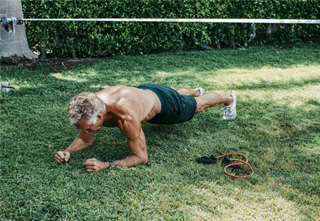 Gyms all across the world are closed right now. Many of us are stuck at home, unable or unwilling to even get to parks and hiking trails and beaches. We’re all homebodies now, and yet the need for physical activity hasn’t diminished. If anything, it’s more crucial than ever that we stay active and healthy, fit and strong.
Gyms all across the world are closed right now. Many of us are stuck at home, unable or unwilling to even get to parks and hiking trails and beaches. We’re all homebodies now, and yet the need for physical activity hasn’t diminished. If anything, it’s more crucial than ever that we stay active and healthy, fit and strong.
Today, we’re going to start with core workouts.
The core is, well, the core. It’s the foundation of your body. It’s how strength and force is transmitted to the world around you. It keeps you upright. And, although this might seem unimportant (it’s not), it’s a major component of LGN—looking good naked. Form and function depend heavily on the strength of your core.
You can do this entire workout in one block, sprinkle it throughout the day, or do some of it every day in addition to other training.
Primal At-Home Core Workout
Planks
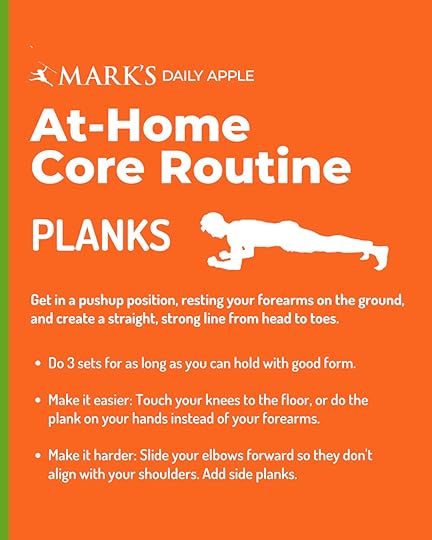
This is the most basic core exercise. It’s simple (but not easy).
Get in the pushup position, only put your forearms on the ground instead of your hands. Your elbows should line up directly underneath your shoulders. Toes on the ground.
Squeeze your glutes and tighten your abdominals.
Keep a neutral (straight, plank-like) neck and spine.
Create a straight, strong line from head to toes—a plank, if you will.
Hold that position for as long as you comfortably can. Stop short of failure.
Rest for a minute and repeat twice more.
Make them easier:
By doing them on your hands rather than forearms (like at the top of a pushup).
By doing them on your knees; rest your knees on the floor or an exercise mat.
Make them harder:
Slide your elbows forward, so they no longer line up underneath your shoulders. This will increase the difficulty.
Add side planks. Hold a side plank on the left side for 30–60 seconds. Switch to the right side and hold for 30–60 seconds.
Watch the video in this link to give you some visual ideas of what to do.
Toes to Bar
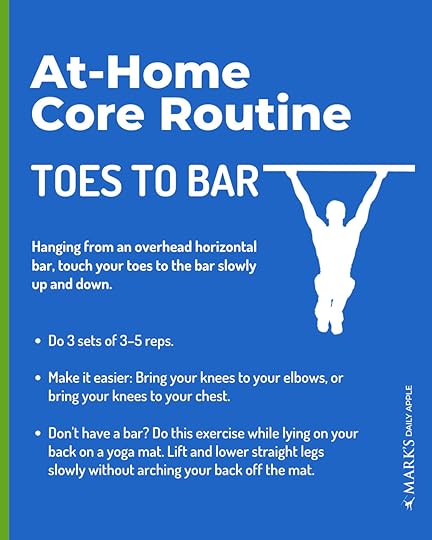
Here’s how to do it:
Hang from an overhead horizontal bar, and touch your toes to the bar. Lift and lower in a slow and controlled manner for 3–5 reps.
If you can’t do the toes to the bar, try just bringing your knees up to your elbows. Again, slow and controlled for 3–5 reps.
If you can’t do the knees to elbows, try bringing your knees up to your chest. Slow and controlled for 5–10 reps.
Do 3 sets, resting for 30 seconds between sets.
Check out the video here for an example.
Hollow Body Rocks
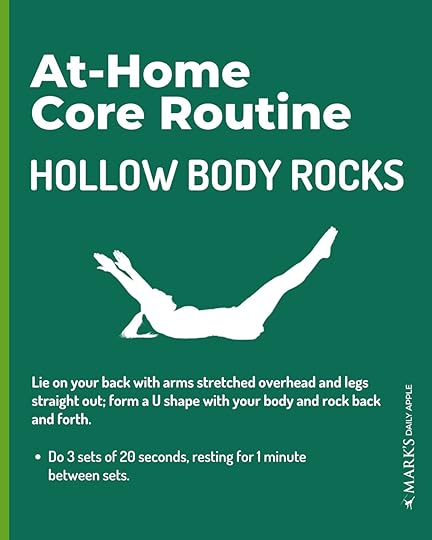
Here’s how you do it:
Lie down on your back with your arms overhead and your legs straight out.
Brace your core and lift your legs and arms slightly off the ground, creating a shallow U with your body.
Start rocking back and forth while maintaining that solid shallow U position with your body.
Rock for 20 seconds. Rest for one minute. Repeat twice.
Hands and Feet
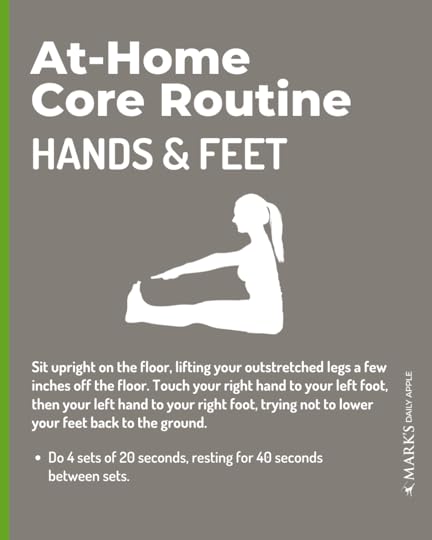
There’s probably a better/more official name for this one, but it’s what I call it.
Sit upright on the ground.
Lift your feet off the floor.
Touch your right hand to your left foot.
Touch your left hand to your right foot.
Keep going, never putting your feet on the ground.
Do this for 20 seconds at a time. Rest for 40 seconds between sets; repeat four times.
Make it easier: Touch your hands to your knees.
Make it harder: Touch your elbows to your ankles.
There you go, that’s the workout. Once again, you can sprinkle these movements throughout the day or do them all in one fell swoop.
How are you training your core these days?
The post Primal At-Home Workout: Core appeared first on Mark's Daily Apple.



March 24, 2020
The Definitive Guide to Body Composition
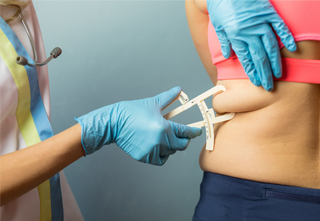 With so many people choosing to track health data nowadays, I get a lot of questions about the best way to measure body composition. Today I’m going to cover some of the most common methods, their pros and cons, and also tackle the question of whether there is an “ideal” body composition.
With so many people choosing to track health data nowadays, I get a lot of questions about the best way to measure body composition. Today I’m going to cover some of the most common methods, their pros and cons, and also tackle the question of whether there is an “ideal” body composition.
When it comes to fitness, body composition refers to the relative quantities of fat, muscle, bone, and water in your body. These are measured by weight or as a percentage of your total body weight. Clinically, body composition differentiates between fat mass or adipose tissue, muscle, bone/bone mineral content, and residual mass (organs, connective tissue). For the purposes of this post, I’m going to focus on “body composition” as it’s used for fitness and general health, not medically.
Body composition is not the same as body weight and height. Two people of the same height and weight can have vastly different body compositions. One might be a very lean, muscular fitness competitor, while the other has a corpulent figure. Nor is body composition the same as build—ectomorph, endomorph, mesomorph.
Body composition is a measure of the building blocks, so to speak. Colloquially, when people talk about body composition, they typically mean how much body fat and lean muscle they carry. Although bone density is technically a part of the equation, I’ve never heard someone say they were going to improve their body composition by increasing bone mineral density.
I’m going to assume that’s what you mean, too: When you say you’re interested in measuring body composition, you want to know your body fat percentage and possibly how much muscle you’re carrying. Likewise, when people ask me whether there is an “ideal” body composition, they want to know whether a certain amount of body fat and muscle are optimal for health and longevity.
A Quick Note On Fat and Muscle
I write about fat and muscle a lot on MDA, but I want to reiterate a couple important points before moving on to the meat of this post.
First, we talk about fat like it’s one uniform thing we carry around in our bellies and butts, but that’s not the case at all. For health purposes, we want to distinguish between white fat and brown fat, and especially between subcutaneous fat and visceral fat. The former is the fat stored under your skin—the stuff you can pinch—while the latter is the relatively more dangerous kind that packs around your internal organs. We’re also learning more about the health risks associated with excess intramuscular fat.
Second, I know I don’t need to convince you that lean muscle is important. Not only does it produce important proteins and metabolites, it correlates with overall health and organ reserve. Having sufficient lean muscle serves a protective role in aging.
From a purely functional perspective—setting aside the aesthetic question—it’s important to have enough lean muscle and not too much body fat. What do “enough” and “not too much” mean, though? I’ll try to provide some insight into that shortly. It’s not as straightforward as you might think. First, though, let’s look at how you measure body composition.
How to Measure Body Composition
There are a variety of ways to assess body composition. For today I’m going to stick to the ones that are widely available. The gold standard for body composition analysis is either CT scan or MRI, but you aren’t going to be using those to track your gainz. Hydrostatic weighing (aka underwater weighing) is also very accurate but not so readily available. Plus you have to be willing to be dunked underwater.
Body weight is not by itself a good measure of adiposity (fatness) or lean mass. Likewise, BMI, which is calculated by dividing weight in kilograms by the square of height in meters, provides a crude estimate of adiposity at best. In fact, BMI was never designed to be a measure of body composition in any given individual. It was meant to look at population-level trends in body size. Various researchers have proposed mathematical adjustments to make BMI a better predictor of fat mass, but it remains imprecise. Your doctor may care about BMI because it’s the anthropometric measure used in most medical research, but it won’t tell you what you want to know here.
Let’s look at some of the ways you can measure body composition relatively easily and affordably, starting with the most sophisticated and working down to the more basic:
Air displacement plethysmography (ADP, aka whole-body air displacement plethysmography)
ADP is similar in principle to hydrostatic weighing. With ADP, you sit inside a small chamber, and body composition is assessed by air displacement. This technology is commercially available as BOD POD®.
The pros of ADP are that it is relatively inexpensive and scores well in terms of reliability. It’s also easy. All you have to do is sit quietly in a big egg, and measurement takes approximately three minutes. It’s not available in all areas, though. The biggest drawback is that it gives you body fat percentage but doesn’t tell you anything about muscle volume. The report simply breaks down fat mass and “other.” It also may not be as accurate for lean individuals.
Dual energy X-ray absorptiometry (aka DXA or DEXA)
DEXA is currently the best option for people who want a comprehensive body composition analysis. In medical settings it is often used to measure bone density to screen for osteoporosis. Many medical offices now offer DEXA scans for general body composition analyses as well, and mobile scanning services operating out of vans are popping up all over.
When you get a DEXA scan, you lie on a table with your legs loosely held down by straps. An arm emitting low-dose x-rays passes over your body while another passes underneath. The scan takes about 10 minutes. The technician then generates a report that includes:
A visual representation of your fat and muscle distribution
Total mass broken down into fat, lean (muscle), and bone, plus visceral fat
Bone density
Detailed analysis of fat versus lean tissue in your left and right arm, leg, and torso
Repeated DEXA scans—completed every three to six months, for example—can be a good way to track your progress if you are actively trying to lose body fat while maintaining muscle, or if you’re trying to bulk up. While generally regarded as very accurate and safe, there are still questions about the accuracy of DEXA’s visceral fat measurement specifically. If visceral fat is your primary concern, try combining repeat DEXA scans with simple abdominal measurements (more below), and follow up with your doctor.
Bioelectrical impedance analysis (BIA)
BIA devices pass small electrical currents through the body. Muscle is a better conductor of electricity than fat or bone, so by measuring the resistance to the current, these devices estimate the relative amounts of fat, muscle, and bone in your body. Because the calculations are based on the amount of water in your tissues, BIA can be thrown off by how well hydrated you are.
BIA technology is popular to its widespread availability and ease of use. There are many types of BIA devices on the market, some more reliable than others. I don’t put much stock in those cheap bathroom scales that claim to tell you your body fat. The more sophisticated InBody machines have been shown to give readings on par with DEXA scans. Unlike scales that only offer body fat readings, InBody devices also offer skeletal muscle mass and, in the more premium devices, visceral fat estimates.
Unless you have access to one of the more expensive devices, I think BIA should be used in the same way as regular bodyweight scales: Use it to track trends over time, but don’t get too hung up on any single measurement. Just as with body weight, BIA can vary for reasons having little or nothing to do with your actual body composition.
Electrical impedance myography (EIM)
Handheld EIM devices like the Skulpt Chisel are another option. Like BIA, EIM works by passing an electric current through tissues at different depths and measuring impedance. EIM is used in medical settings to measure muscle quality, or muscle strength relative to size. The technology has more recently been adapted to fitness tracking.
are another option. Like BIA, EIM works by passing an electric current through tissues at different depths and measuring impedance. EIM is used in medical settings to measure muscle quality, or muscle strength relative to size. The technology has more recently been adapted to fitness tracking.
The advantages of these devices are that they are easy to use at home, allowing for daily tracking of body composition if you want. The Skulpt device gives you full-body and 12 region-specific (right/left shoulder, chest, biceps, etc.) measurements of muscle quality and body fat percentage. One study showed it to be fairly reliable when compared to DEXA, at least in young, healthy individuals. It’s not clear how accurate the device is in people with higher levels of body fat.
Skinfold devices
Skinfold calipers, aka plicometers, are extremely cheap and simple. When used with proper technique, they are reasonably accurate, although not as accurate as any of the methods already listed. I’d guess that most people using calipers to measure their own fat at home aren’t properly trained to use them, though, which means they almost certainly aren’t getting accurate results.
Calipers can only measure subcutaneous fat. They tell you nothing about visceral fat or lean tissue. Measurements are also affected by age, gender, and fat distribution. Given that there are much better options available now, I don’t think skinfold measurements have much to offer anymore other than being inexpensive unless (a) all you care about is subcutaneous fat, and (b) a trained pro is taking the measurements for you.
Tape measure
Navy body fat formula: The Navy body fat formula simply requires two measurements for males (waist at navel and neck) or three for females (waist at narrowest point, hip, and neck). Plug those values into one of the many online calculators to get your fat mass, body fat percentage, and lean mass.
The Navy adopted this method because it was looking for something that was relatively reliable and easier to train personnel to do correctly compared to skinfold calipers. Although it has its detractors, the Navy validated this method against hydrostatic weighing and found it to be acceptable.
Waist-to-hip ratio, waist-to-height ratio, or waist circumference: None of these measurements provides information about body fat versus lean mass. However, they may be indicative of having more of the dangerous visceral fat. As a health marker, abdominal fatness is more directly linked to negative health outcomes than fat that is distributed across your entire body.
Summary:
If you care to have a very accurate, detailed reading, spring for a DEXA scan. From what I’ve seen, they are much more accessible and affordable now than they used to be, at least in the U.S. DEXA is also your best bet if you want to assess bone health.
If you just want a body fat estimate that’s good enough for tracking fitness or setting your keto macros, the Navy body fat measurements will do.
Tracking a simple waist measurement is a good idea for health reasons. If yours starts to climb, it’s time to dig deeper into diet or lifestyle variables that might be at play. (Stress causes abdominal fat accumulation, for example.)
Whichever method you choose, understand that it will have some degree of error. That’s not a huge deal in the context of tracking body comp for fitness and general health.
Know, though, that body composition assessments tend to be less reliable in obese individuals. Studies find small gender differences as well, and there may be systematic errors based on other demographic characteristics. This is all the more reason not to get hung up on the exact number. Instead, track trends over time to see how your body composition is changing or staying more or less the same.
Is There An Ideal Body Composition?
First we have to define what we mean by “ideal.” Let’s set aside the aesthetic question. It’s subjective, and it changes across time and cultures. Anyway, as much as I’m open about my desire to LGN (look good naked), I also maintain that function trumps form. That is, I care more about how my body functions than how it looks.
“Ideal” body composition should therefore reflect the amount of fat and lean muscle that leads to optimal functioning: staying healthy and strong for the longest time possible. The questions I’d like to answer here are:
At what body fat percentage are people, on average, healthiest?
How much lean muscle tissue is optimal for health?
The thing is, I can’t. The data just isn’t there. Oh, there are plenty of studies looking at the relationship between BMI and health risk factors, chronic disease, or mortality. As I’ve said, though, BMI is a poor substitute for actual measures of body composition.
There are also smaller but sizable literatures looking at specific measurements—waist circumference, waist-to-hip ratio, DEXA, BIA—and those same outcome measures. Trying to glean specific recommendations from the literature is tough, though, for a few reasons:
Results vary by age, gender, probably race/ethnicity, and according to what outcome variable you’re talking about.
Researchers frequently divide people into categories—low, medium, high body fat, or low versus high waist circumference—when assessing risk. That means we can’t pinpoint specific thresholds for body fat or muscle that might be ideal.
Studies are inconsistent in what possible confounding variables the researchers control for. In particular, smoking is a known confound in this area of research because it is associated with both lower body weight and more health problems. Still, not all studies control for it.
The biggest problem, though, the one that even the best-designed study won’t overcome, is that there is a lot of individual variability. Take 100 people with the same body fat percentage, and their health could vary tremendously. There are just too many factors that interact to create health, including the likely interaction between body fat and lean muscle.
All that said, we can make some broad generalities. In general, risk of developing metabolic syndrome, type 2 diabetes, and cardiovascular disease seems to increase with increased body fat. Again, though, there is a lot of variance from study to study that makes it impossible to nail down any kind of firm cut-offs.
When risk increases more or less linearly, how do you decide where the cut-off is between “still ok” and “getting into the danger zone?” It’s tough.
If I had to make any kind of recommendation, I’d probably tell you to track simple waist circumference. It’s easy to assess, and this research showed that when waist circumference is used as a continuous variable—that is, not broken into categories like “normal” or “high,” which are always imperfect—it predicts risk of hypertension, dyslipidemia, and metabolic syndrome by itself. Adding BMI to the equation didn’t increase predictive power.
In the U.S., the NIH recommends a cutoff of 102 cm (~40 inches) for men and 88 cm (~34.5 inches) for women as a healthy cut-off. The International Diabetes Foundation recommends a cutoff of 80 cm in women, 94 cm in men of European descent, and 90 cm in South Asian, Chinese, and Japanese men. The European Union recommends a cutoff of 94 cm for men and 80 cm for non-pregnant women. So as you see, it’s still somewhat subjective.
Nevertheless, being in the ballpark or below is probably a decent goal. Perhaps more importantly, you want to track over time. If you’re slightly above the cutoff but stable and otherwise healthy, I’d be less concerned than if you were seeing waistline expansion year over year.
What about muscle, you might ask? Same thing, I don’t have a great answer. A recent review concluded that having less lean body mass predicted greater mortality until old age, at which point the association disappears or perhaps even reverses. I’m of the mind that when it comes to muscle, measuring amount is less important than measuring strength or functional capacity. The goal for most of us isn’t to be jacked when we’re old. It’s to be mobile and independent, with a firm handshake.
Finally, I’d be remiss if I didn’t mention that although we usually talk about risk at the higher end of body fat percentage, you can of course go too low as well. The minimum body fat percentage for survival, known as essential fat, is 2–5% for men and 10–13% for women. Many people, especially women, need considerably more to feel well and have healthy hormone balance. Low body fat is a risk factor for hypothalamic amenorrhea (losing one’s period), but there are no specific guidelines for what constitutes “too low.” It varies from woman to woman.
Bottom Line
We don’t have the fine-grain data to definitively say what amount of body fat and lean muscle is optimal. Being at the extremes seems clearly associated with poor health and mortality. Beyond that, there is a significant range in the middle where any given individual could be considered healthy.
In the absence of specific and reliable recommendations, I’m going to say what I’ve been saying all along: Lifestyle is more important than any one measurable data point. If you’re checking all the boxes—eating plenty of plants and animals, moving your body, resistance training, getting lots of sleep and sunlight, managing stress, nurturing social connections—that’s the most important thing.
If you want to try to get from 20% body fat to 17% body fat for aesthetic reasons, hey, that’s up to you. Just understand that losing that 3% body fat doesn’t necessarily buy you significantly better health, especially if you use extreme measures to do it.
Do I think it’s worth having a general sense of how much body fat and muscle you’re carrying? Yeah, probably. If nothing else, it’s good to make sure that you’re not losing significant muscle mass as you age. A yearly or biannual DEXA scan plus checking in semi-regularly with your waist circumference seems like a reasonable plan. DEXA will also allow you to track your bone mineral density, which is important. If you need to know your body fat for the purposes of setting your keto macros, something like the Navy body fat calculator will do just fine.
Otherwise, I’m more interested in subjective markers like how I feel on a day-to-day basis and whether I can perform at the gym. My jeans and my mirror tell me everything I need to know about abdominal fat. I don’t need to know exactly how many pounds of lean muscle I’m packing to know whether I’m as strong as I want to be and whether I can get off the floor after playing with my granddaughter.
What about you? What measures do you use to track your body composition—if you even do? What other body composition questions do you have? Tell me in the comments below.
References
Aune, D., Schlesinger, S., Norat, T., & Riboli, E. (2018). Body mass index, abdominal fatness, and the risk of sudden cardiac death: A systematic review and dose–response meta-analysis of prospective studies. European Journal of Epidemiology, 33(8), 711–722.
Collins, M. A., Millard-Stafford, M. L., Sparling, P. B., Snow, T. K., Rosskopf, L. B., Webb, S. A., & Omer, J. (1999). Evaluation of the BOD POD for assessing body fat in collegiate football players. Medicine and Science in Sports and Exercise, 31(9), 1350–1356.
Fields, D. A., Goran, M. I., & McCrory, M. A. (2002). Body-composition assessment via air-displacement plethysmography in adults and children: A review. The American Journal of Clinical Nutrition, 75(3), 453–467.
Flegal, K. M., Shepherd, J. A., Looker, A. C., Graubard, B. I., Borrud, L. G., Ogden, C. L., Harris, T. B., Everhart, J. E., & Schenker, N. (2009). Comparisons of percentage body fat, body mass index, waist circumference, and waist-stature ratio in adults. The American Journal of Clinical Nutrition, 89(2), 500–508.
Francis, P., Lyons, M., Piasecki, M., Mc Phee, J., Hind, K., & Jakeman, P. (2017). Measurement of muscle health in aging. Biogerontology, 18(6), 901–911.
Gallagher, D., Heymsfield, S. B., Heo, M., Jebb, S. A., Murgatroyd, P. R., & Sakamoto, Y. (2000). Healthy percentage body fat ranges: An approach for developing guidelines based on body mass index. The American Journal of Clinical Nutrition, 72(3), 694–701.
Hames, K. C., Anthony, S. J., Thornton, J. C., Gallagher, D., & Goodpaster, B. H. (2014). Body composition analyses by air displacement plethysmography in adults ranging from normal weight to extremely obese. Obesity (Silver Spring, Md.), 22(4), 1078–1084.
Knapp, K. M., Welsman, J. R., Hopkins, S. J., Shallcross, A., Fogelman, I., & Blake, G. M. (2015). Obesity increases precision errors in total body dual-energy x-ray absorptiometry measurements. Journal of Clinical Densitometry: The Official Journal of the International Society for Clinical Densitometry, 18(2), 209–216.
Lee, D. H., & Giovannucci, E. L. (2018). Body composition and mortality in the general population: A review of epidemiologic studies. Experimental Biology and Medicine, 243(17–18), 1275–1285.
Lee, D. H., Keum, N., Hu, F. B., Orav, E. J., Rimm, E. B., Willett, W. C., & Giovannucci, E. L. (2018). Predicted lean body mass, fat mass, and all cause and cause specific mortality in men: Prospective US cohort study. BMJ, 362.
Lee, S. Y., & Gallagher, D. (2008). Assessment methods in human body composition. Current Opinion in Clinical Nutrition & Metabolic Care, 11(5), 566–572.
Ling, C. H. Y., de Craen, A. J. M., Slagboom, P. E., Gunn, D. A., Stokkel, M. P. M., Westendorp, R. G. J., & Maier, A. B. (2011). Accuracy of direct segmental multi-frequency bioimpedance analysis in the assessment of total body and segmental body composition in middle-aged adult population. Clinical Nutrition (Edinburgh, Scotland), 30(5), 610–615.
McLester, C. N., Dewitt, A. D., Rooks, R., & McLester, J. R. (2018). An investigation of the accuracy and reliability of body composition assessed with a handheld electrical impedance myography device. European Journal of Sport Science, 18(6), 763–771.
Meredith-Jones, K., Haszard, J., Stanger, N., & Taylor, R. (2018). Precision of DXA-Derived Visceral Fat Measurements in a Large Sample of Adults of Varying Body Size. , 26(3), 505–512.
Pahor, M., Manini, T., & Cesari, M. (2009). Sarcopenia: Clinical evaluation, biological markers and other evaluation tools. The Journal of Nutrition, Health & Aging, 13(8), 724–728.
Peterson, D. D. (2015). History of the U.S. Navy Body Composition Program. Military Medicine, 180(1), 91–96.
Prado, C. M. M., & Heymsfield, S. B. (2014). Lean Tissue Imaging. JPEN. Journal of Parenteral and Enteral Nutrition, 38(8), 940–953.
Rutkove, S. B. (2009). Electrical Impedance Myography: Background, Current State, and Future Directions. Muscle & Nerve, 40(6), 936–946.
Silver, H. J., Welch, E. B., Avison, M. J., & Niswender, K. D. (2010). Imaging body composition in obesity and weight loss: Challenges and opportunities. Diabetes, Metabolic Syndrome and Obesity: Targets and Therapy, 3, 337–347.
Thomas, T. R., & Etheridge, G. L. (1980). Hydrostatic weighing at residual volume and functional residual capacity. Journal of Applied Physiology, 49(1), 157–159.
Vescovi, J. D., Zimmerman, S. L., Miller, W. C., Hildebrandt, L., Hammer, R. L., & Fernhall, B. (2001). Evaluation of the BOD POD for estimating percentage body fat in a heterogeneous group of adult humans. European Journal of Applied Physiology, 85(3–4), 326–332.
Wingo, B. C., Barry, V. G., Ellis, A. C., & Gower, B. A. (2018). Comparison of segmental body composition estimated by bioelectrical impedance analysis and dual-energy X-ray absorptiometry. Clinical Nutrition ESPEN, 28, 141–147.

The post The Definitive Guide to Body Composition appeared first on Mark's Daily Apple.



March 23, 2020
What to do When You’ve Hit a Weight Loss (or Other) Plateau
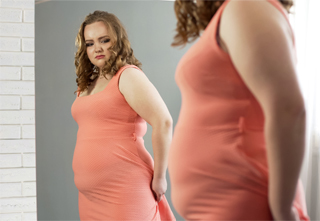 Tell me if this sounds familiar: You started making changes in your life to get healthier and everything was going great. You were seeing progress in the way you felt and looked, your cravings were down, and your energy was up. It was working!
Tell me if this sounds familiar: You started making changes in your life to get healthier and everything was going great. You were seeing progress in the way you felt and looked, your cravings were down, and your energy was up. It was working!
Then, all of sudden it wasn’t.
Despite doing everything right, the scale hasn’t budged in a week, your motivation has hit an all-time low, and you feel totally betrayed by your body. As a health coach, I see a lot of my clients struggling with weight loss plateaus, and feelings that change isn’t happening fast enough. And do you know why? It’s because of this little nugget of truth:
Long-term change is a process.
There’s no such thing as a quick fix for a weight loss plateau. So, if you’ve been holding on to extra weight for years or you’re regularly feasting on fake health foods, don’t expect your habits or your weight to change overnight. It took you awhile to get where you are. And honestly, the faster your “transformation” happens, the faster you’ll undo all your progress.
But I get it. You’re putting in all this hard work, and if you’re still seeing zero or very few changes, just know that your body is a miraculous machine designed to keep you alive and protect you at all costs. When you change your environment, including the type and amount of fuel you consume, your body wants to make sure you’re safe. So, it’s normal to experience plateaus here and there.
Remember, change isn’t an instantaneous event—it takes commitment, patience, and the right strategies to stick with it for the long term. In fact, Australian researchers conducted a qualitative study, interviewing 76 people with a BMI of 30 or over to find out why their previous weight-loss attempts had failed.
In the study, participants received instructions on how to lose weight through various plans, but none were given guidance on how to stick with it. Seventy percent of the participants noted that while no particular diet was better than others for weight loss, tapping into their own motivation for change was the key factor in being successful for the long term.
With that in mind, here are the go-to tips I use in my own practice when my clients feel like they’ve stalled out on progress.
6 Things to do When You’ve Hit a Plateau
1. Remember Where You Started
Maybe you’ve made some progress, but you’re not as far along as you’d like. All you can hear yourself say is, “I can’t believe I’ve only lost 3 pounds,” or “my pants are only a little looser.” Don’t discount how far you’ve come. If you used to buy lunch every day and now you’re taking the time to prep a healthier meal at home, that’s huge. Take a step back and think about how things have changed since you started your journey. Also, have patience.
2. Remember Why You Started
Getting in touch with why you started can help put things into perspective. My Why-by-Five exercise is a tool I use with my health coaching clients to uncover their true motivating factors for change. Just ask yourself why this change is important to you, why that matters, why this reasoning is important, why your goal would be great to achieve, and why it’s important to keep going.
3. Keep a “Proof List”
When things aren’t going exactly as planned, it’s easy to feel like nothing’s working at all. That’s why having a proof list can help you navigate the highs and lows. Every day, write down something positive about your health journey. It could be that you tightened your belt buckle by one notch. Or the Big-Ass Salad you made was so satisfying you didn’t want cookies afterward. Keep a running list and add to it regularly.
4. Set an Intention Versus an Expectation
Expecting that you’ll lose a certain number of pounds or fit into an old pair of pants is the quickest way to disappointment. Instead, set a few healthy intentions. Good examples I’ve heard from my clients are: “I want to be a good role model for my kids,” or, “I am open to taking things one day at a time.” Expectations have a concrete result; intentions are more about your mindset and behavior.
5. Break it Down
Since your goals aren’t going to magically happen overnight, you need a system for making your new healthy habits stick for the long term. I recommend breaking your goal down into mini milestones. Avoiding refined carbs forever feels daunting, but what about avoiding them for this week? By creating mini milestones and then rewarding yourself for reaching them, you’re more apt to maintain your new habits and feel successful doing it.
6. Believe in Yourself
The simple act of believing in yourself plays a big role in achieving your goals faster. According to psychologist Albert Bandura’s Self-Efficacy Theory, if you don’t believe you have the ability to complete a task, you’ll be less likely to start. And if you do start, you’re more likely to give up before it’s finished. Self-efficacy is a sense of personal conviction that you can overcome any challenge you might face and successfully stay the course.
In a world of quick fixes, it’s normal to feel like your goals aren’t happening fast enough. Just know that change is a long-term process that requires commitment, patience, and smart strategies like these:
Remember where you started
Remember why you started
Keep a “proof list”
Set an intention versus an expectation
Break it down
Believe in yourself
The post What to do When You’ve Hit a Weight Loss (or Other) Plateau appeared first on Mark's Daily Apple.



March 21, 2020
Loaded Stuffed Sweet Potatoes
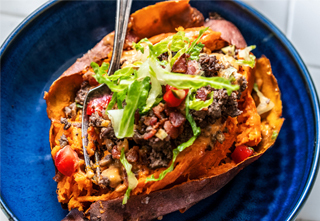 Potato diets, ’80s throwback when aerobics queens sipped diet coke and ate plain baked potatoes, or forgotten side next to the creamed spinach and ribeye… whatever your memories of baked potatoes may be, you likely no longer think of them as “tonight’s dinner.” But baked sweet potatoes can make delightful pockets for Primal fillings such as ground venison, bacon, and avocado. This loaded stuffed sweet potato makes a great post-workout or post long endurance run, swim, or ride meal.
Potato diets, ’80s throwback when aerobics queens sipped diet coke and ate plain baked potatoes, or forgotten side next to the creamed spinach and ribeye… whatever your memories of baked potatoes may be, you likely no longer think of them as “tonight’s dinner.” But baked sweet potatoes can make delightful pockets for Primal fillings such as ground venison, bacon, and avocado. This loaded stuffed sweet potato makes a great post-workout or post long endurance run, swim, or ride meal.
Loaded Stuffed Sweet Potatoes
Time: 70 minutes
Servings: 1
Ingredients
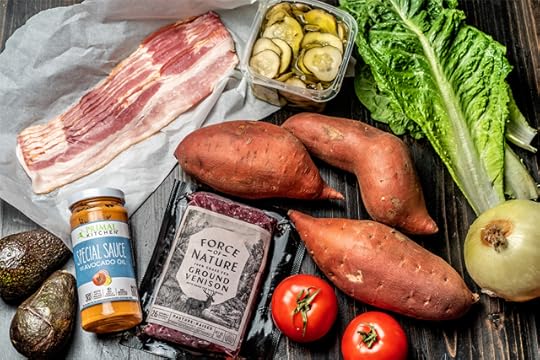
1 sweet potato
1-2 tablespoons Primal Kitchen®Avocado Oil
1/2 teaspoon coarse sea salt
2 strips bacon
1/4 small onion, diced
1 pound ground venison*
1 teaspoon salt
1/2 teaspoon black pepper
1/4 cup pickles, diced
1/4 tomato, diced
1/4 cup lettuce, shredded
1/4 avocado, sliced
2 tablespoons Primal Kitchen Special Sauce
*you’ll use about 1/3 cup cooked for 1 serving
Instructions
Preheat the oven to 425ºF.
Wash the skin of the sweet potato. Prick sweet potato with a fork. Rub with 1 tablespoon avocado oil, and sprinkle the outside with coarse sea salt.
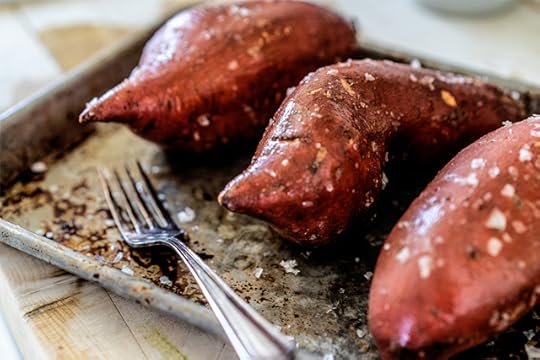
Place sweet potato directly on the rack of the oven. Place a pan underneath the sweet potato to catch any drippings.
Roast sweet potato for about 50 minutes, or until the thickest part of the potato has no resistance.
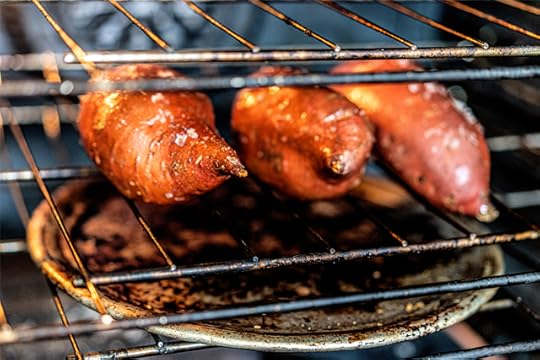
Remove potato from oven, set aside, and turn off the oven.
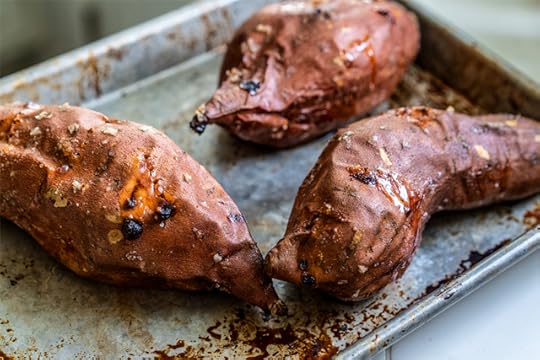
Dice bacon. In a large skillet over medium-high heat, add bacon and cook until your desired crispness.
Remove bacon from the skillet and drain on paper towels.
Add onion to the skillet and cook, stirring frequently, for 2 minutes. Add ground venison to the skillet, breaking it up into small chunks. Venison is a leaner cut of meat, so if your skillet is too dry, add 1 tablespoon avocado oil, and stir.

Cook venison until it’s browned, stirring occasionally and continuing to break up large pieces. Once cooked, stir in pickles, then turn off the heat.

Make a slit down the middle of the cooled sweet potato, taking care not to cut all the way through the bottom skin of the potato. Pull the halves apart carefully without tearing the potato in two.
Spoon about 1/3 cup of the ground venison into the sweet potato pouch. Save the rest of the ground venison for leftovers or another recipe.
Top the sweet potato with the cooked bacon, diced tomato, shredded lettuce, sliced avocado, and Special Sauce. Serve immediately.
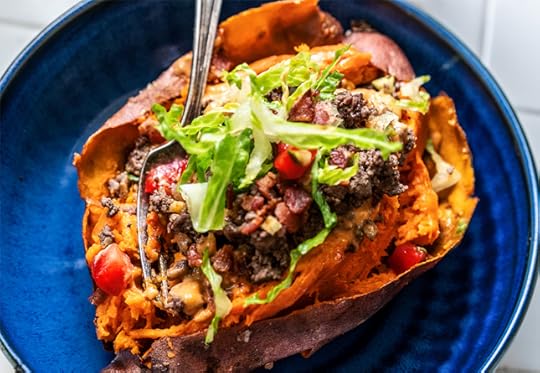
Nutrition Info (per serving):
Calories: 609
Total Carbs: 40 grams
Net Carbs: 32 grams
Fat: 37 grams
Protein: 29 grams
The post Loaded Stuffed Sweet Potatoes appeared first on Mark's Daily Apple.



March 20, 2020
Weekly Link Love – Edition 73

Research of the Week
Malaria drug shows promise against coronavirus.
Coronavirus shows different levels of stability on different surfaces.
Coronavirus patients may have lower cholesterol. No word on causation—could very well be that infection decreases cholesterol.
A study in Thailand finds that hospitalized coronavirus patients tend to have low potassium levels.
New Primal Blueprint Podcasts
Episode 409: Gary E. Foresman: Host Elle Russ welcomes Dr. Gary Foresman back to the podcast.
Episode 410: Matt Maruca: A Youthful Journey to Healing, and Overcoming Harmful Blue Light Excess: Host Brad Kearns chats with Matt Maruca about his story and his mission.
Episode 411: Dr. Terry Wahls: Elle Russ chats with Dr. Terry Wahls about her Wahls Protocol for autoimmune disease.
Episode 412: Brian Hoyer: The Dangers of EMF Exposure and How to Make Your Bedroom a Safe Haven: Host Brad Kearns talks EMF with Brian Hoyer.
Primal Health Coach Radio, Episode 52: Laura and Erin chat with Samantha Gladish, who just wants you to carve your own path.
Media, Schmedia
According to some reports, 40% of those hospitalized for coronavirus were aged 20-54.
3D printers save the day in Italian hospital by printing respirator valves.
Interesting Blog Posts
How South Korea is doing so well in the fight.
Social Notes
Now this is how you quarantine.
How penguins are handling the crisis.
Everything Else
What seed oils to do your body, a video.
The benefits of keto for non-alcoholic fatty liver disease.
Things I’m Up to and Interested in
Nice story: Brooklyn pharmacist supplying NYC docs with chloroquine for coronavirus patients.
Result I found interesting: “High fever (39°C) was associated with higher likelihood of ARDS development (HR, 1.77; 95% CI, 1.11-2.84) and lower likelihood of death (HR, 0.41; 95% CI, 0.21-0.82).”
I can’t really disagree: Factory farms are an abomination.
Nice overview: Immune cell modulation by the ketogenic diet.
Just as I suspected: How pollution aggravates coronavirus severity.
Question I’m Asking
How are you handling the coronavirus situation personally? How is it impacting you and your family?
Recipe Corner
If you’re gonna pig out on something sweet, at least include some protein.
Sauteéd reindeer.
Time Capsule
One year ago (Mar 15–Mar 21)
The Real Deal on Keto Body Odor – How do you smell?
5 Hemp Oil Benefits for Health and Wellness– All about CBD.
Comment of the Week
“I just shared this poem with my family:
‘The Peace of Wild Things’
When despair for the world grows in me
and I wake in the night at the least sound
in fear of what my life and my children’s lives may be,
I go and lie down where the wood drake
rests in his beauty on the water, and the great heron feeds.
I come into the peace of wild things
who do not tax their lives with forethought
of grief. I come into the presence of still water.
And I feel above me the day-blind stars
waiting with their light. For a time
I rest in the grace of the world, and am free.
– Wendell Berry”
– Beautiful, Debbie D.

The post Weekly Link Love – Edition 73 appeared first on Mark's Daily Apple.



March 19, 2020
Soothing Soup, Bone Broth, and Tea Recipes
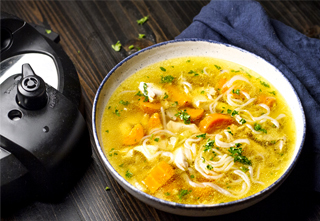 When viruses and bacterial infections swirl around us, and especially during the winter and early spring months when the weather can seesaw between sunny and pleasant, and thundering and soggy, warm soups, bone broths, and teas can fortify and evoke warm fuzzy feelings (even if they’re fleeting until the next bowl or mug). These soup, bone broth, and tea recipes can help soothe when you’re feeling worn out or ill, and warm you up when the weather won’t.
When viruses and bacterial infections swirl around us, and especially during the winter and early spring months when the weather can seesaw between sunny and pleasant, and thundering and soggy, warm soups, bone broths, and teas can fortify and evoke warm fuzzy feelings (even if they’re fleeting until the next bowl or mug). These soup, bone broth, and tea recipes can help soothe when you’re feeling worn out or ill, and warm you up when the weather won’t.
Bone Broth Recipes
Chicken Bone Broth Four Ways
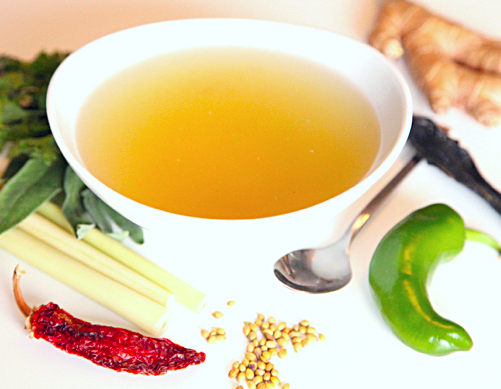
Learn how to make basic chicken bone broth, plus four ways to accessorize it. Great for sipping, but also for use in other recipes, the Thai chicken bone broth enhances stir-fry and Asian dishes, and the spicy chicken broth adds a kicky Tex-Mex appeal to sauces.
Beef Bone Broth Variations

A deeply savory way to drink in the nourishing benefits of gelatin, beef bone broth can be dressed up several eclectic ways to tickle your palate. Reduce the butter and leek beef bone broth to a thin glaze and drizzle over steamed or roasted vegetables for transformative taste.
Instant Pot Turkey Bone Broth

If you haven’t tried turkey bone broth yet, you’re in for a pleasing surprise. A touch more gamey and intense than chicken bone broth, turkey bone broth can add savory and meaty flavor to veggie mashes, cauliflower rice, pan sauces, and more.
Instant Pot Chicken Bone Broth & Chicken Bone Broth Latte
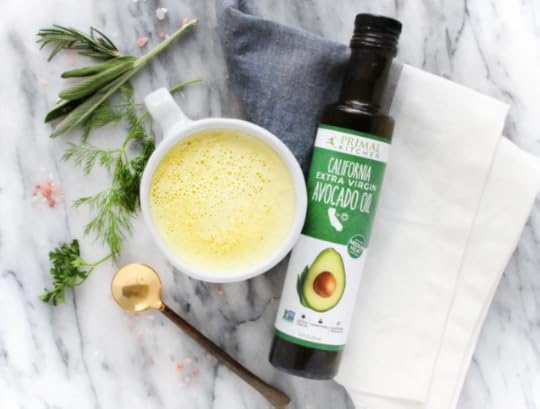
This is a classic chicken bone broth recipe with a couple of modern embellishments: a few glugs of apple cider vinegar, and chucking all ingredients into an Instant Pot. Scroll through the recipe to the bottom for a keto snack: a chicken bone broth latte.
Soup Recipes
19 Keto Soups

From Fat-Bomb Hamburger Soup to Greek Lemon Chicken Soup, there’s something for every Primal-keto taste in this soup roundup.
Gut Repair Sweet Potato Soup
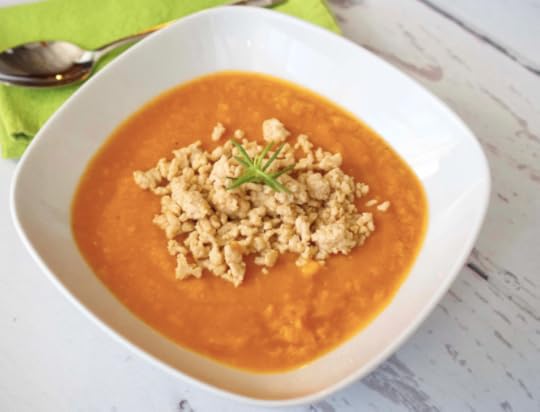
Made with butternut squash, sweet potatoes, and three scoops of collagen peptides, this soup can help soothe a disgruntled stomach. We figure you won’t give the side eye to a suggested meat garnish; the caramelized bits of ground turkey sprinkled on top of this pumpkin-hued pureed soup provides nice chewy contrast.
Turmeric and Kale Soup with Ground Lamb

This soup is loaded with ingredients that can potentially ease the symptoms of the common cold, or give your immune system a little boost during cold and flu season. The healing properties from this sharp, slightly spicy broth come from ginger, garlic, turmeric, lemon, and bone broth.
Instant Pot Chicken “Noodle” Soup

Grandma’s and mother’s remedy for what ails, chicken noodle soup can be Primal when made with golden chicken broth from skin-on chicken thighs, aromatic vegetables, and shiritaki angel hair noodles.
Slow Simmered Cabbage Soup with Sausage

Although buttery, slow-simmered cabbage can be a dish in itself, add broth and sausage and you’ll get a very simple soup with incredibly rich, comforting flavor. Choose the best-quality butter you can afford to add plenty of unctuousness to this basic soup.
Garlic Soup with Mushrooms and Chive Oil

Redolent of the infamous 40 garlic clove chicken dish, this garlic soup uses 15 cloves of garlic. Don’t fret; your significant other and even furry friend won’t stay away forever if you eat this. The soup calls for roasted garlic, which mellows and smooths out the sharp pungency of the bulb.
Ginger Soup with Scallops and Shrimp

Ginger has long been thought to be a natural immune booster. Ginger adds an intensity of flavor to stock that is both soothing and invigorating. It awakens your senses and warms you right to your core. Just-cooked scallops and shrimp add substance to this spicy broth.
Green Tea Chicken Soup
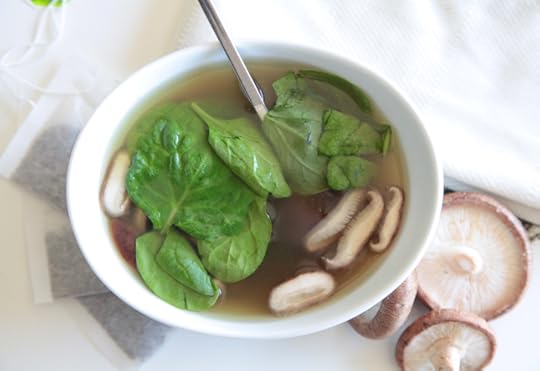
A touch bitter, this chicken soup adds interest through steeping green tea bags or leaves in the broth. This seven-ingredient soup comes together in just 25 minutes.
Tea Recipes
Creamy Turmeric Tea

Turmeric tea will perk you up in the morning, calm you down at night and soothe sniffles and sore throats. It’s also a really pleasant way to end a meal.
3 Collagen Tea Latte Recipes

More delicate than coffee lattes with the potential to be every bit as craveable, tea lattes have expanded beyond the boxes of chai and matcha and into under-explored and exotic territories. Soothe an upset stomach with a Collagen Mint Tea Latte; switch up your normal chai to a citrusy Lemon Cardamom Collagen Latte; and instead of a pumpkin spice latte, try a Roobios Vanilla Spice Collagen Tea Latte.
Read More: Benefits of Bone Broth & Tea, and Immune-Boosting Tips
Is Bone Broth Nutritious?
Does Bone Broth Break a Fast?
Is it Safe to Microwave Bone Broth?
Bone Broth FAQs
The Pros and Cons of Tea
The Definitive Guide to Tea
8 Common Cold Cures That Actually Seem to Work
7 Drinks to Boost Your Immune System

The post Soothing Soup, Bone Broth, and Tea Recipes appeared first on Mark's Daily Apple.



March 18, 2020
Dear Mark: Coronavirus Questions
 Okay, so this situation is upon us. There’s no denying that all anyone can focus on is the coronavirus. There are several different names used for it, but I’ll use coronavirus and COVID-19 for today’s post. I asked across different venues for your questions and concerns about the topic. I tried to get to as many as I could.
Okay, so this situation is upon us. There’s no denying that all anyone can focus on is the coronavirus. There are several different names used for it, but I’ll use coronavirus and COVID-19 for today’s post. I asked across different venues for your questions and concerns about the topic. I tried to get to as many as I could.
Let’s just get into it:
Why do you think kids have not been so affected?
Good question. Many of the more serious issues with this happen in the lungs as a result of prior “co-morbidities” such as smoking, diabetes, COPD, or just having lived in an area of high air pollution for many years. Then there’s the notion that much of the damage that happens to infected people happens as a result of “cytokine storms,” an example of an immune system over-reacting to the insult. Because adults have been exposed to other strains of flu over their lives and have other antibodies for those flus, there might be a dangerous “mismatch” between what’s needed for COVID-19 and what their arsenal currently holds. Kids haven’t had the time to develop all the mismatched antibodies. All speculation.
And also, kids definitely have the potential to carry and transmit the virus even if they themselves don’t exhibit strong symptoms. One recent Chinese study found that 90% of kids with the virus were asymptomatic or showed just mild or moderate symptoms.
How safe do you think U.S. kids are?
I think kids are quite safe as long as this is reasonably curtailed.
When they say risk increases with age, they mean cellular age, not chronological right?
I hope so! That’s certainly part of it. If you are healthier and more robust in general, regardless of chronological age, you are likely to be more “robust” when under immune assault.
Tips for pregnant women and COVID-19?
Do whatever you can to avoid exposure. Full stop.
The CDC maintains a page for information regarding pregnancy and breastfeeding with COVID-19, but frankly it’s a lot of “we don’t know.” So far according to the CDC there is no known transmission from mother to baby via amniotic fluid or breastmilk. Of course, please consult your doctor immediately if you are pregnant and develop any symptoms.
Do you think that it’s overhyped or a real danger?
Both. It’s a real danger for some (mostly older infirm individuals with co-morbidities) and they should do whatever they can to avoid contracting. OTOH, the damage to the world economy is even now almost incalculable. How much of this was due to over-hype versus just poor prior planning will be the subject of debate for decades to come.
I do think once more testing rolls out, we’ll see that far more people are infected than we think, but that the fatality/severity rate drops.
Why the fear and hysteria from the media… what am I missing?
Humans are story-tellers by our nature. We have always used storytelling as the primary means of communication. Fireside tales, books, radio, TV, movies, Internet, gaming, school history classes, jokes—they are all stories. Every good story needs a villain. In this case, the media has found the consummate villain: an actual threat that hits all the right notes. In order to compete with other media outlets (and hence to sell ads) the tendency is to take a set of facts and weave them into a narrative that is both compelling and horrifying. COVID-19 allows for an infinite number of tales of woe and heroics—not to mention the ability for all sides to play politics with the other side.
Is it really as bad as the media is putting on?
IMO, no, but it’s early days and the situation is changing every hour. We will see.
According to UK researchers who created a mathematical model of transmissibility, each coronavirus case infected on average 2.6 other people in Wuhan. They also estimated that blocking over 60% of transmission would be necessary for infection-control measures to effectively control the outbreak. The outbreak is worsening in Europe, particularly in Italy as of today, but South Korea appears to have slowed its epidemic for now. This article in Science Mag credits the slowing number of new cases in South Korea to diagnostic capacity at scale, tracing contact with infected persons, and case isolation.
There’s another angle that I haven’t seen discussed much: air pollution. Wuhan is notoriously polluted, with terrible air quality and high levels of particulates in the air. The population also smokes quite heavily, particularly the men (who happen to be at greater risk). Smoking (and, I imagine, constant exposure to air particulate pollution) has been shown to increase ACE2 expression. That could very well be why it hit that area so hard.
If you catch & recover, is there a chance of future health issues as a result of having had it?
Apparently, reports are that a smallish percentage of people who contract this and recover are left with some damage to lung and or cardiac tissue. Maybe that recovers over time. Too early to opine. The same thing happened with SARS, if I recall correctly.
Can you get it more than once?
Remains to be seen. Some researchers are saying yes, that people are getting re-infected. Others are saying a person can “recover” but the virus lies dormant and reemerges. We just don’t know and won’t until long-term data is available.
Do you think fasting would have any positive effect on resisting it?
I would not undergo any dramatic fasting protocols at this time. I personally would adhere to my compressed eating window and limit intake to healthy fats, quality proteins, and organic vegetables. Fresh is great, but frozen and some (BPA-free) canned, jarred, vacuum-packed, and pantry items can provide quality Primal nutrition as well.
How does keto affect the body’s immune system?
In most cases a keto diet seems to support a healthy immune system, provided the foods you are eating are real, natural, etc. Whether that offers any specific protection against COVID-19 is impossible to say.
Do you think we should transition to workouts that aren’t at a public gym?
I would certainly limit my exposure to other peoples’ sweat and exhaled gases. I don’t plan to do any public gym workouts, and now most gyms have closed temporarily or will likely close across the country as the virus continues to spread. There are tons of things you can do in your home or your yard or even in a vacant field.
This is the perfect opportunity to get outside, get some sun (or cold), and move your body through fresh air. The fresh air will reduce the risk of transmission, as will the lack of people around you. The sun will increase nitric oxide, which showed some effectiveness at reducing the ability of a related virus—SARS—to replicate. And exercise is a great way to improve your overall health and resilience, as well as get out of the house and out of your own mind.
Best practices for fevers?
Stay hydrated (water and electrolytes; salty lime/lemon water). Stay in bed. Rest.
Avoid sugar and refined carbs. Sugar is one of the worst immune suppressors.
Do all the things your body is telling you to do.
In adults, I see no reason to reduce it until you’re getting to very serious temperatures—over 105, 106ºF. There’s actually very little evidence that fever in and of itself is dangerous. Rather, this study suggests that it’s whatever’s causing the fever that’s dangerous. The fever is the response. Animal studies indicate that treating fever with anti-pyretics might actually increase the risk of mortality, at least in influenza.
In fact, news stories are circulating, questioning whether it’s advised for patients to take ACE inhibitors and anti-inflammatory drugs such as ibuprofen if they’re experiencing COVID-19 symptoms. An article published on Science Alert suggests that the World Health Organization is digging into research presented in The Lancet that hypothesizes that COVID-19 patients with diabetes, cardiac diseases, or hypertension who are treated with ACE2-increasing drugs are at a higher risk for severe (and possibly fatal) infection. There’s concern among cardiology societies about these suggestions; the WHO has yet to release an official recommendation.
But, of course, if you’re running an extended fever and you suspect you might have coronavirus, get medical attention immediately and let them take it from there.
Are endurance athletes more at risk?
Probably. I say that because most endurance athletes overtrain to the point of occasional immune compromise. Now is not the time for that. Cut training back to 40% during this time.
Meat and corona?
Possibly my favorite meal.
My son is 22 and has asthma. Should I be worried?
Given the recent data, he is probably less likely to suffer severe consequences if he is infected based on his age, even though most of the severest cases involve lung and/or cardiac damage. Still, if I had asthma, I would do everything possible not to contract this. Not worth the risk.
Do you think when the sun comes out to play again this will die down?
I think it will absolutely help. Check out this thread on the UV index of the most affected areas. It really does seem like UV and weather and humidity can affect the viability of the virus and its ability to take hold, but this is all speculation.
A real problem will be the damage done to global economies. That might take a while to recover.
Good items to stock up on?
See Primal Provisioning for Staying at Home.
Would you travel during this outbreak?
Absolutely not.
Will taking vitamin D help people avoid getting sick?
This is a tricky one. Normally, I’d say yes, it can’t hurt and very well might help. But with coronavirus, that gets more complicated. One thing vitamin D may have the potential to do is increase ACE2 expression, and ACE2 is the same receptor to which coronavirus binds. It’s the “entry point,” how it gets in and starts destroying cells. Organs with high rates of ACE2 receptors, like the lungs, appear to be the most affected organs.
If vitamin D increases ACE2 in the lungs, for example, that could leave you more open to infection. I certainly would avoid “megadoses” of vitamin D. If you take it, do something like 1000 IUs max, or get it through food (salmon, sardines, pastured eggs, mushrooms) or cod liver oil.
Similar to the Spanish flu in 1918?
Maybe. It seems to show some similar patterns, but diverges in others. Basic concept of virulence seems similar and the same danger of overloading the medical system applies.
Tips on remaining calm and perspective amongst the panic?
The majority of the damage will be done and over in a few months. Accept what is, and know that you are doing the best you can with the tools you have.
Avoid stress. Stress increases ACE2 expression, dampens general immunity, and makes your time hanging out and relaxing impossible and miserable.
I read somewhere that a low-carb diet and high doses of vitamin C could reduce one’s chance of getting (seriously) sick from the virus. Is there any proof on that or reason to believe those claims are true?
Probably very little proof, but it’s not out of the realm of possibility. The single best thing you can do to shore up immunity is avoid sugars and industrial seed oils, get sleep, limit stress. One of the co-morbidities I’m seeing bandied about in serious patients are blood sugar disregulation, type 2 diabetes, and other conditions linked to poor glucose tolerance. In that case, using a low-carb diet to normalize glucose levels certainly won’t hurt. Of course, you don’t have to go low-carb to normalize glucose levels; it’s just that many people find that works for them.
Vitamin C has promise. There were reports of Chinese doctors using IV vitamin C in patients and having success. IV vitamin C is a little difficult to arrange at home, but oral vitamin C is perfectly safe even at high doses and liposomal vitamin C seems to be even more effective than plain oral vitamin C.
Is it possible that frequent hand washing and sanitizer could actually hurt us by removing beneficial protective bacteria? I’m washing but also bathing my hands in dirt.
You have to look at this from two angles: acute and chronic.
Chronic sanitization of our environments and bodies promotes a worse immune system that’s more susceptible to illness and more likely to overreact to otherwise innocuous inputs.
Acute sanitization of our environments and bodies can protect us against dangerous microbes.
If you’re picking lettuce out of your garden, you can probably eat it without washing your hands.
If you’re in LAX (Los Angeles International Airport) opening the bathroom stall, touching the faucet, and flushing toilets, you should wash your hands.
And if there’s “something going around,” it’s a good idea to wash your hands and be a little more vigilant. Native Americans had robust immune systems and got plenty of microbial exposure and likely had incredibly impressive gut biomes and very little incidence of autoimmune diseases. But when they encountered smallpox, they died. They were vulnerable to an entirely novel infectious agent because they’d never encountered it before and it was sufficiently virulent.
Preparation we DO need to make… What are you doing???
I’m staying in my condo with Carrie. I have enough food stored for several weeks. I’m only going outside to go to the beach right outside the building, go for rides on the beach, runs, sprints, etc.
Staying calm, staying serene, and being prepared.
Also, read this thread and take it to heart.
That’s it for today, folks. If you have any follow-ups, I can try to get to them for next time. Ask away down below. Thanks for reading, and make sure to take care of yourself and your family.
The post Dear Mark: Coronavirus Questions appeared first on Mark's Daily Apple.



March 17, 2020
Primal Provisioning For Staying Home
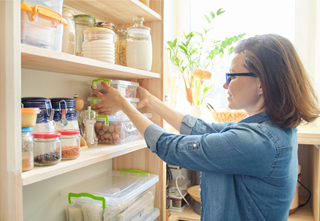 How’s everyone doing out there? I hope you are all doing your best to protect your health, including your mental health. These are wild times to say the least.
How’s everyone doing out there? I hope you are all doing your best to protect your health, including your mental health. These are wild times to say the least.
I don’t know what it is like in your neck of the woods. Where I live, a lot of people saw the writing on the wall at the end of last week and prepared to self-quarantine. Stores were suddenly packed as people stocked up with the necessary supplies to stay home for several weeks. (Yes, and dozens of rolls of paper towels and toilet paper, too.)
I’m sure many of you have already put recommended social distancing policies into place. If you haven’t stocked your homes with supplies that will allow you to avoid going out as much as possible, now’s the time. I’m going to focus on prepping your kitchen today. Don’t forget the other parts, though: prescription and over-the-counter medicines, basic hygiene (soap, laundry detergent), pet food.
How Much Do I Really Need?
That’s hard to say. The U.S. Department of Homeland Security recommends having a two-week supply of food. On the other hand, it’s clear from some of the hardest-hit areas around the world that we all face the possibility of staying in for longer than that. A lot of people are stocking up for longer, but please remember that everyone needs to shop now. Prepare for a few weeks, yes. Hoard for months, no.
I’m sensitive to the fact that not everybody has the resources to buy two or three weeks of food at one time. Even in countries that have implemented strict closures, grocery stores have remained open. That means we can hope and expect that we’ll be able to shop for more food as we need it even if stricter quarantines go into effect. Of course, do what you can to be safe—avoid crowds, keep your distance from other shoppers, don’t go out if you’re feeling sick, wash your hands after leaving the store.
What Should I Get?
You’ll want to pick up extra frozen and shelf-stable food. Also get your usual groceries—meat, eggs, produce, and so on—to last through the first week.
In my opinion, this isn’t the time to split hairs between “Primal” and “not Primal.” Yes, it’s great to stick to your normal nutrient-dense foods to support overall wellness right now. At the same time, if you’d feel more comfortable having a pound of dried beans in your cupboard just in case, go for it.
Obviously don’t buy food that makes you sick. Beans work for me; they might not work for you. I’m also not advocating you dive face-first into sheet cake. Just don’t let perfect be the enemy of good, especially if your stores have limited supplies right now. Make the best decisions you can, but the last thing any of us needs is unnecessary added stress right now.
Provisions List
The list below is to give you ideas. You obviously don’t need everything here.
BEFORE SHOPPING
Check your spice cabinet. I’m not putting any herbs and spices on the list, so add any you want to restock.
Check your salt. Cooking without salt is a major bummer, plus you want to keep your electrolytes up.
Take stock of what you already have in your fridge and pantry. Don’t bother to buy more tuna if you already have a whole case. Leave some for the next shopper.
STOCK YOUR FRIDGE
Fresh meat/poultry/seafood to cook the first week
Fresh produce to cook the first week
Eggs
Condiments (salad dressings, mayo, ketchup & mustard)
Fermented foods*: sauerkraut, pickles, kimchi (gut health is always important!)
Dairy products: Greek yogurt, cheese, cream for your coffee
Don’t forget that a lot of produce actually doesn’t require refrigeration, such as:
Avocados (keep them in the fridge to delay ripening, though)
Potatoes, sweet potatoes
Winter squashes: acorn, spaghetti, kabocha, delicata, pumpkins
Stone fruits: peaches, plums, nectarines
Apples, pears
Citrus fruits (just watch for rotten ones—they’ll spoil everything)
Whole melons
Bananas
Onions
Garlic
Peppers (store in a paper bag)
STOCK YOUR FREEZER
Frozen meat/poultry
Frozen fish
Frozen vegetables (for smoothies, don’t forget frozen greens and even avocados if you can find them)
Frozen berries
Butter
STOCK YOUR PANTRY
Canned/tinned fish
Coffee/tea
Collagen
Cooking oils (olive, coconut, avocado, etc.), ghee
Coconut milk
Nuts & nut butter
Bone broth
Pasta sauce
Grain-free pasta (e.g., Banza)
Jerky, beef sticks, biltong, hard salami
Olives
Grain-free crackers
Grain-free granola
Whey protein powder
Protein bars
Dark chocolate
Non-dairy milk in Tetra Paks
Creamer like Better Half and Nutpods (shelf stable until opened)
Beans
Quinoa
Lentils
Rice
*Note that fermented foods that are shelf stable, like sauerkraut and pickles, have been heat-treated. That kills the living organisms that make fermented foods so beneficial for health. That doesn’t mean you can’t enjoy shelf-stable pickles or sauerkraut, of course, but don’t eat them for their probiotics.
**The items in italics are ones that I would consider “borderline” foods in terms of Primal sensibilities.
BAKING (OPTIONAL)
Chia seeds
Hemp seeds
Flax seeds
Coconut flakes
Coconut flour
Almond flour
Paleo pancake mix (e.g., Birch Benders)
MISCELLANY
Electrolytes
Parchment paper
Food storage containers and bags
GENERAL TIPS
If you’re feeling anxious about leaving the house or, for example, you’re immunocompromised and need to take extra precautions, consider grocery delivery services like Instacart and Amazon Prime Whole Foods delivery. Last time I looked, they were predictably running much slower than usual, but they were still operating. Some grocery stores do curbside pick-up so you don’t have to get out of your car. Order meat and seafood online if you have freezer space. If you have a favorite brand of protein bar or gluten-free bread or whatever, look to see if you can order directly from the company.
Expect that everything might be slower than normal and supplies might be limited. Plan ahead if you can, but also don’t hoard food. And yes, I know that’s vague. We’re all figuring this out as we go along.
If you have kids at home, this is a great time to get them involved with cooking. Little ones can help you wash produce, stir ingredients, brush oil, tear lettuce, and break apart broccoli and cauliflower. Older kids can progress to using different kitchen appliances with supervision, cutting herbs with scissors, chopping ingredients once they can handle a knife, and helping read recipes to you while you cook.
Minimize Waste
One way to avoid having to shop more often is to make the most of what you have. Here are my three favorite ways to avoid waste:
Make bone broth with all your vegetable and meat scraps and bones. I use my slow cooker because I can add scraps to it over a day as I cook, but the stovetop or a pressure cooker also works great. You can also freeze scraps to use later.
If you have a stockpile of nuts, you can make your own nut milk for coffee or chia pudding. Then use the pulp in recipes, such as these from Elana Amsterdam of Elana’s Pantry.
If your freezer isn’t full, freeze leftovers before they go bad so you can thaw and reheat them later.
GO EASY ON YOURSELF
Like I said, we’re all figuring this out as we go along. I know a lot of people are dealing with financial and food insecurity right now. If you need support or ideas for how to make it through, please reach out in the comments.
The post Primal Provisioning For Staying Home appeared first on Mark's Daily Apple.



Mark Sisson's Blog
- Mark Sisson's profile
- 199 followers















